Study on the Crop Suitability and Planting Structure Optimization in Typical Grain Production Areas under the Influence of Human Activities and Climate Change: A Case Study of the Naoli River Basin in Northeast China
Abstract
:1. Introduction
2. Materials and Methods
2.1. Study Area
2.2. Framework
2.3. Data Source
2.3.1. Crops’ Spatial Information
2.3.2. Variables and Sources
- Environmental variables
- 2.
- Human activities
- 3.
- Future climate variables
- 4.
- Data processing
2.4. Simulation and Prediction by MaxEnt
2.4.1. Model Mechanism
2.4.2. Model Evaluation
2.4.3. Existence Probability and Crop Layout Optimization
3. Results
3.1. Model Evaluation
3.2. Potential Distribution and Suitability Levels
3.3. Optimized Cropping Structure
3.4. Identification of Dominant Factors and Threshold Characteristics
3.5. Characteristics of Dominant Factors
3.6. Distribution of Crop Suitability under Future Climate
4. Discussion
4.1. Factors Influencing Crop Optimization Layout
4.2. Impacts of Dominant Factors on Crop Planting
4.3. Impacts of Human Activities on Planting Structures
4.4. Potential Impacts of the Watershed’s Ecological and Water Security
4.5. Limitations and Prospects
5. Conclusions
- The MaxEnt model accurately simulated crop suitability when considering the comprehensive influence of human activities along with natural environmental factors compared to when only considering natural factors.
- The suitability distribution of different crops varied, with maize having the largest area of medium and suitable regions, followed by rice and soybeans.
- The highly suitable areas for major crops in the Naoli River Basin were primarily concentrated in the central plain area of the basin rather than in areas with higher population density, indirectly indicating highly mechanized and large-scale agricultural production in the basin.
- Population density (POP) and accessibility (DR) were the main human activity factors influencing the distribution of crop suitability, especially for soybeans.
- Climate change had varying degrees of impact on crop suitability, with maize being the most affected. Under low-emission scenario climate models, there was no significant change in maize’s suitability, while the suitability of rice and soybeans increased. Under high-emission scenario models, the suitable area for all crops decreased, posing challenges to regional food security due to climate change.
Author Contributions
Funding
Institutional Review Board Statement
Informed Consent Statement
Data Availability Statement
Acknowledgments
Conflicts of Interest
References
- Feng, L.; Wang, H.; Ma, X.; Peng, H.; Shan, J. Modeling the current land suitability and future dynamics of global soybean cultivation under climate change scenarios. Field Crop. Res. 2021, 263, 108069. [Google Scholar] [CrossRef]
- Rising, J.; Devineni, N. Crop switching reduces agricultural losses from climate change in the United States by half under RCP 8.5. Nat. Commun. 2020, 11, 4991. [Google Scholar] [CrossRef]
- Gil, J.D.B.; Reidsma, P.; Giller, K.; Todman, L.; Whitmore, A.; Van Ittersum, M. Sustainable development goal 2: Improved targets and indicators for agriculture and food security. Ambio 2019, 48, 685–698. [Google Scholar] [CrossRef]
- Yang, S.; Wang, H.; Tong, J.; Ma, J.; Zhang, F.; Wu, S. Technical Efficiency of China’s Agriculture and Output Elasticity of Factors Based on Water Resources Utilization. Water 2020, 12, 2691. [Google Scholar] [CrossRef]
- Xiao-guang, Y.; Zhi-juan, L.I.U.; Fu, C. The Possible Effects of Global Warming on Cropping Systems in China Ⅰ. The Possible Effects of Climate Warming on Northern Limits of Cropping Systems and Crop Yields in China. Sci. Agric. Sin. 2010, 43, 329–336. [Google Scholar]
- Fujimori, S.; Hasegawa, T.; Krey, V.; Riahi, K.; Bertram, C.; Bodirsky, B.L.; Bosetti, V.; Callen, J.; Despres, J.; Doelman, J.; et al. A multi-model assessment of food security implications of climate change mitigation. Nat. Sustain. 2019, 2, 386–396. [Google Scholar] [CrossRef]
- Jiang, L.; Jiapaer, G.; Bao, A.; Guo, H.; Ndayisaba, F. Vegetation dynamics and responses to climate change and human activities in Central Asia. Sci. Total Environ. 2017, 599–600, 967–980. [Google Scholar] [CrossRef]
- Lombardo, U.; Iriarte, J.; Hilbert, L.; Ruiz-Perez, J.; Capriles, J.M.; Veit, H. Early Holocene crop cultivation and landscape modification in Amazonia. Nature 2020, 581, 190–193. [Google Scholar] [CrossRef] [PubMed]
- Zhu, Z.; Piao, S.; Myneni, R.B.; Huang, M.; Zeng, Z.; Canadell, J.G.; Ciais, P.; Sitch, S.; Friedlingstein, P.; Arneth, A.; et al. Greening of the Earth and its drivers. Nat. Clim. Chang. 2016, 6, 791–795. [Google Scholar] [CrossRef]
- Lobell, D.B.; Field, C.B. Global scale climate–crop yield relationships and the impacts of recent warming. Environ. Res. Lett. 2007, 2, 014002. [Google Scholar] [CrossRef]
- Tao, F.; Zhang, Z. Impacts of climate change as a function of global mean temperature: Maize productivity and water use in China. Clim. Chang. 2011, 105, 409–432. [Google Scholar] [CrossRef]
- Lawler, J.J.; Shafer, S.L.; White, D.; Kareiva, P.; Maurer, E.P.; Blaustein, A.R.; Bartlein, P.J. Projected climate-induced faunal change in the Western Hemisphere. Ecology 2009, 90, 588–597. [Google Scholar] [CrossRef] [PubMed]
- Bisbis, M.B.; Gruda, N.; Blanke, M. Potential impacts of climate change on vegetable production and product quality–A review. J. Clean Prod. 2018, 170, 1602–1620. [Google Scholar] [CrossRef]
- Song, Y.; Lu, Y.; Liu, T.; Li, H.; Yue, Z.; Liu, H.; Gao, T. Variation of vegetation fractional coverage and its relationship with climate in a desert steppe: Optimization of farmland layout in a farming-pastoral ecotone using the ecological suitability index. Ecol. Eng. 2020, 150, 105834. [Google Scholar] [CrossRef]
- Arowolo, A.O.; Deng, X. Land use/land cover change and statistical modelling of cultivated land change drivers in Nigeria. Reg. Environ. Chang. 2018, 18, 247–259. [Google Scholar] [CrossRef]
- Ladha, J.K.; Jat, M.L.; Stirling, C.M.; Chakraborty, D.; Pradhan, P.; Krupnik, T.J.; Sapkota, T.B.; Pathak, H.; Rana, D.S.; Tesfaye, K.; et al. Achieving the sustainable development goals in agriculture: The crucial role of nitrogen in cereal-based systems. Adv. Agron. 2020, 163, 39–116. [Google Scholar] [CrossRef]
- Yan, X.; Liu, M.; Zhong, J.; Guo, J.; Wu, W. How human activities affect heavy metal contamination of soil and sediment in a long-term reclaimed area of the Liaohe River Delta, North China. Sustainability 2018, 10, 338. [Google Scholar] [CrossRef]
- Hao, L.; Su, X.; Singh, V.P.; Ayantobo, O.O. Spatial Optimization of Agricultural Land Use Based on Cross-Entropy Method. Entropy 2017, 19, 592. [Google Scholar] [CrossRef]
- Yang, S.; Wang, H.; Tong, J.; Bai, Y.; Alatalo, J.M.; Liu, G.; Fang, Z.; Zhang, F. Impacts of environment and human activity on grid-scale land cropping suitability and optimization of planting structure, measured based on the MaxEnt model. Sci. Total Environ. 2022, 836, 155356. [Google Scholar] [CrossRef]
- Tang, Y.H.; Luan, X.B.; Sun, J.X.; Zhao, J.F.; Yin, Y.L.; Wang, Y.B.; Sun, S.K. Impact assessment of climate change and human activities on GHG emissions and agricultural water use. Agric. For. Meteorol. 2021, 296, 108218. [Google Scholar] [CrossRef]
- Abdelaal, M.; Fois, M.; Fenu, G.; Bacchetta, G. Using MaxEnt modeling to predict the potential distribution of the endemic plant Rosa arabica Crep. in Egypt. Ecol. Inform. 2019, 50, 68–75. [Google Scholar] [CrossRef]
- Tan, J.; Li, A.; Lei, G.; Xie, X. A SD-MaxEnt-CA model for simulating the landscape dynamic of natural ecosystem by considering socio-economic and natural impacts. Ecol. Model. 2019, 410, 108783. [Google Scholar] [CrossRef]
- He, Q.; Zhou, G. The climatic suitability for maize cultivation in China. Chin. Sci. Bull. 2012, 57, 395–403. [Google Scholar] [CrossRef]
- Duan, J.; Zhou, G. Potential distribution of rice in china and its climate characteristics. Acta Ecol. Sin. 2011, 31, 6659–6668. [Google Scholar]
- Duan, J.; Zhou, G. Climatic suitability of double rice planting regions in China. Sci. Agric. Sin. 2012, 45, 218–227. [Google Scholar]
- Zhang, K.; Zhang, Y.; Zhou, C.; Meng, J.; Sun, J.; Zhou, T.; Tao, J. Impact of climate factors on future distributions of Paeonia ostii across China estimated by MaxEnt. Ecol. Inform. 2019, 50, 62–67. [Google Scholar] [CrossRef]
- Bai, X.F.; Wang, B.; Qi, Y. The effect of returning farmland to grassland and coniferous forest on watershed runoff—A case study of the Naoli River Basin in Heilongjiang Province, China. Sustainability 2021, 13, 6264. [Google Scholar] [CrossRef]
- Dai, X.L.; Wang, Y.; Li, X.H.; Wang, K.; Zhou, J.; Ni, H.W. Effects of temporal and spatial changes in wetlands on regional carbon storage in the Naoli River Basin, Sanjiang Plain, China. Land 2023, 12, 1300. [Google Scholar] [CrossRef]
- Wang, J.-J.; Liu, Z.-R.; Wan, S.-Q.; Han, H.-Y.; Zhu, W.-Z.; Zhang, Z.-T.; Huang, W.-L.; Zeng, H. Relatively stable metal(loid) levels in surface soils of a semiarid Inner Mongolia steppe under multiple environmental change factors. Geoderma 2019, 352, 268–276. [Google Scholar] [CrossRef]
- Kogo, B.K.; Kumar, L.; Koech, R.; Kariyawasam, C.S. Modelling climate suitability for rainfed maize cultivation in Kenya using a maximum entropy (MaxENT) approach. Agronomy 2019, 9, 727. [Google Scholar] [CrossRef]
- Xian, Y.; Liu, G.; Yao, H. Predicting the current and future distributions of major food crop designated geographical indications (GIs) in China under climate change. Geocarto Int. 2022, 37, 8148–8171. [Google Scholar] [CrossRef]
- Yu, X.; Tao, X.; Liao, J.; Liu, S.; Xu, L.; Yuan, S.; Zhang, Z.; Wang, F.; Deng, N.; Huang, J.; et al. Predicting potential cultivation region and paddy area for ratoon rice production in China using Maxent model. Field Crop. Res. 2022, 275, 108372. [Google Scholar] [CrossRef]
- Sun, D.; Wang, Y.; Li, H.; Zhang, W.; Zhou, L. Spatializing regional fertilizer input based on MODIS NDVI time series. Trans. Chin. Soc. Agric. Eng. 2010, 26, 175–180. [Google Scholar]
- Singh, C.; Dorward, P.; Osbahr, H. Developing a holistic approach to the analysis of farmer decision-making: Implications for adaptation policy and practice in developing countries. Land Use Policy 2016, 59, 329–343. [Google Scholar] [CrossRef]
- Lalani, B.; Dorward, P.; Holloway, G.; Wauters, E. Smallholder farmers’ motivations for using Conservation Agriculture and the roles of yield, labour and soil fertility in decision making. Agric. Syst. 2016, 146, 80–90. [Google Scholar] [CrossRef]
- Fiorella, K.J.; Bageant, E.R.; Schwartz, N.B.; Thilsted, S.H.; Barrett, C.B. Fishers’ response to temperature change reveals the importance of integrating human behavior in climate change analysis. Sci. Adv. 2021, 7, eabc7425. [Google Scholar] [CrossRef] [PubMed]
- Bouramdane, A.A. Assessment of CMIP6 multi-model projections worldwide: Which regions are getting warmer and are going through a drought in Africa and Morocco? What changes from CMIP5 to CMIP6? Sustainability 2023, 15, 690. [Google Scholar] [CrossRef]
- Lei, Y.W.; Chen, J.; Xiong, L.H. A comparison of CMIP5 and CMIP6 climate model projections for hydrological impacts in China. Hydrol. Res. 2023, 54, 330–347. [Google Scholar] [CrossRef]
- Douglas, H.C.; Harrington, L.J.; Joshi, M.; Hawkins, E.; Revell, L.E.; Frame, D.J. Changes to population-based emergence of climate change from CMIP5 to CMIP6. Environ. Res. Lett. 2023, 18, 014013. [Google Scholar] [CrossRef]
- Wu, T.W.; Lu, Y.X.; Fang, Y.J.; Xin, X.G.; Li, L.; Li, W.P.; Jie, W.H.; Zhang, J.; Liu, Y.M.; Zhang, L.; et al. The Beijing Climate Center Climate System Model (BCC-CSM): The main progress from CMIP5 to CMIP6. Geosci. Model Dev. 2019, 12, 1573–1600. [Google Scholar] [CrossRef]
- Phillips, S.J.; Anderson, R.P.; Schapire, R.E. Maximum entropy modeling of species geographic distributions. Ecol. Model. 2006, 190, 231–259. [Google Scholar] [CrossRef]
- Elith, J.; Phillips, S.J.; Hastie, T.; Dudik, M.; Chee, Y.E.; Yates, C.J. A statistical explanation of MaxEnt for ecologists. Divers. Distrib. 2011, 17, 43–57. [Google Scholar] [CrossRef]
- Cao, J.; Wang, H.; Li, J.; Tian, Q.; Niyogi, D. Improving the forecasting of winter wheat yields in Northern China with machine learning-dynamical hybrid subseasonal-to-seasonal ensemble prediction. Remote Sens. 2022, 14, 1707. [Google Scholar] [CrossRef]
- Heumann, B.W.; Walsh, S.J.; McDaniel, P.M. Assessing the application of a geographic presence-only model for land suitability mapping. Ecol. Inform. 2011, 6, 257–269. [Google Scholar] [CrossRef]
- Dai, S.; Zhao, B. Trends and challenges of ecosystem observations in the age of big data. Biodivers. Sci. 2016, 24, 85–94. [Google Scholar] [CrossRef]
- Chhogyel, N.; Kumar, L.; Bajgai, Y.; Jayasinghe, L.S. Prediction of Bhutan’s ecological distribution of rice (Oryza sativa L.) under the impact of climate change through maximum entropy modelling. J. Agric. Sci. 2020, 158, 25–37. [Google Scholar] [CrossRef]
- Wezel, A.; Vincent, A.; Nitsch, H.; Schmid, O.; Dubbert, M.; Tasser, E.; Fleury, P.; Stoeckli, S.; Stolze, M.; Bogner, D. Farmers’ perceptions, preferences, and propositions for result-oriented measures in mountain farming. Land Use Policy 2018, 70, 117–127. [Google Scholar] [CrossRef]
- Yuan, B.; Guo, J.; Ye, M.; Zhao, J. Variety distribution pattern and climatic potential productivity of spring maize in Northeast China under climate change. Chin. Sci. Bull. 2012, 57, 3497–3508. [Google Scholar] [CrossRef]
- Chen, H.; Li, Z.G.; Tang, P.Q.; Hu, Y.N.; Tan, J.Y.; Liu, Z.H.; You, L.Z.; Yang, P. Rice area change in Northeast China and its correlation with climate change. J. Appl. Ecol. 2016, 27, 2571–2579. [Google Scholar] [CrossRef]
- He, P.; Li, J.; Wang, X. Wheat harvest schedule model for agricultural machinery cooperatives considering fragmental farmlands. Comput. Electron. Agric. 2018, 145, 226–234. [Google Scholar] [CrossRef]
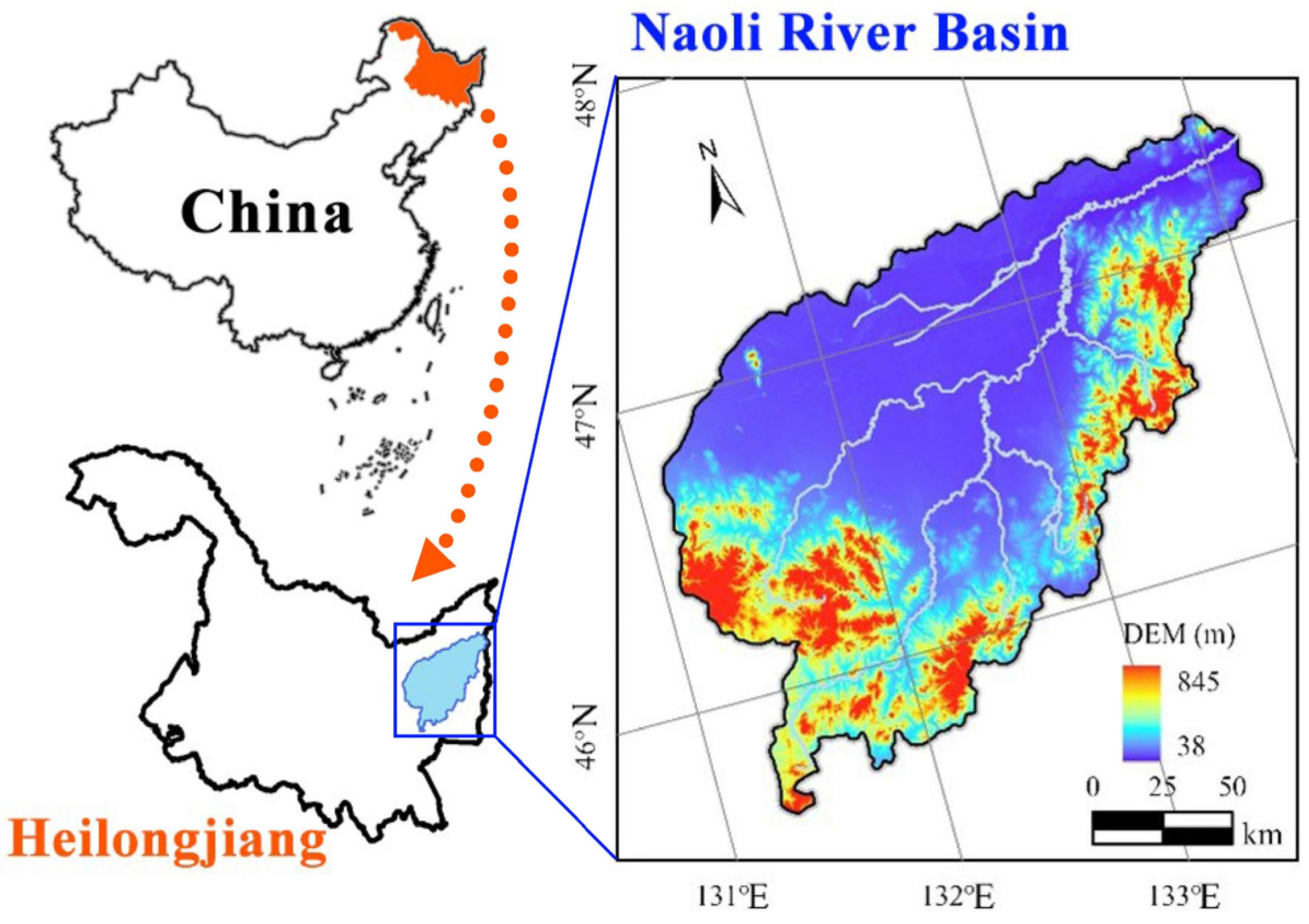

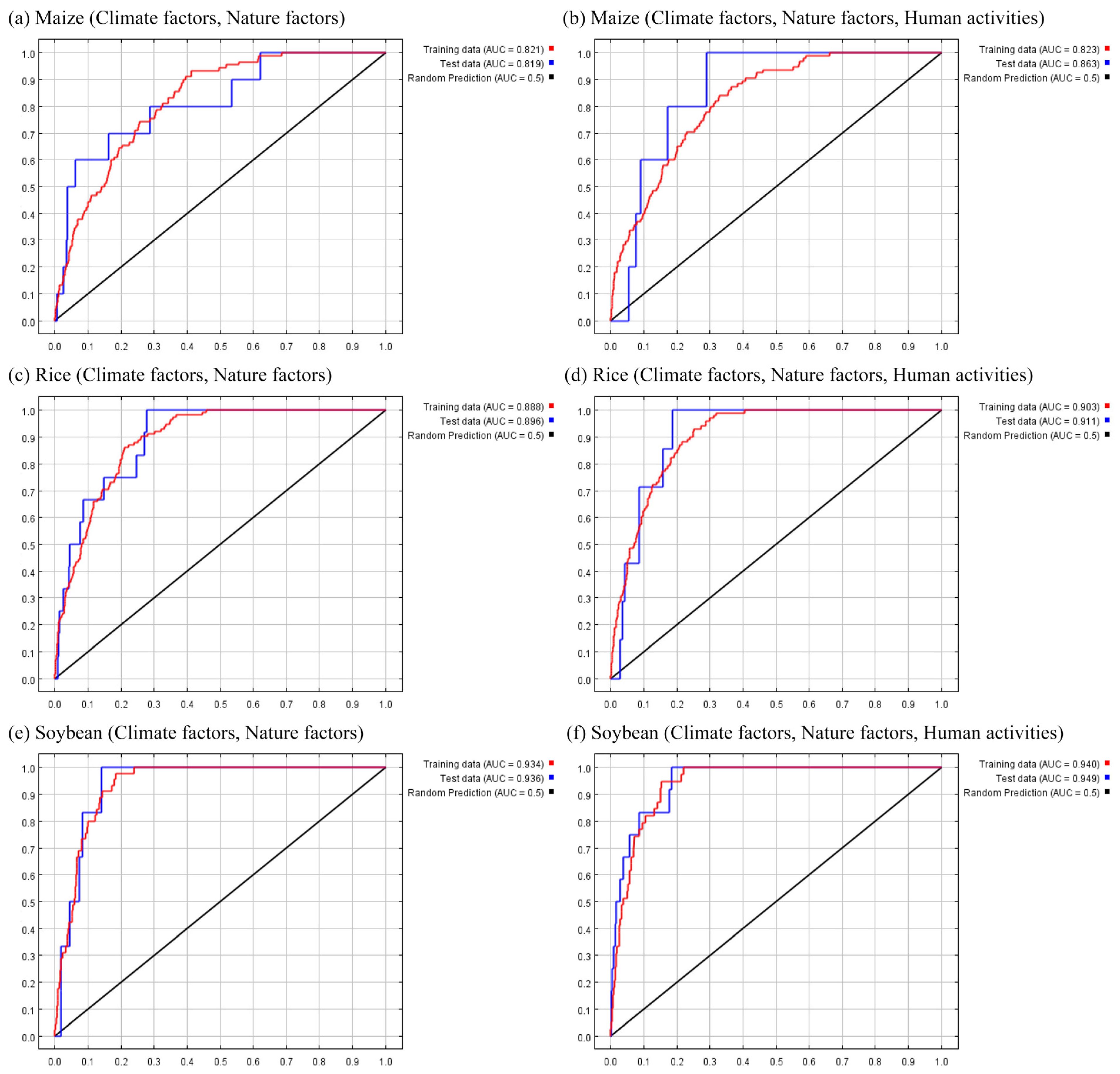

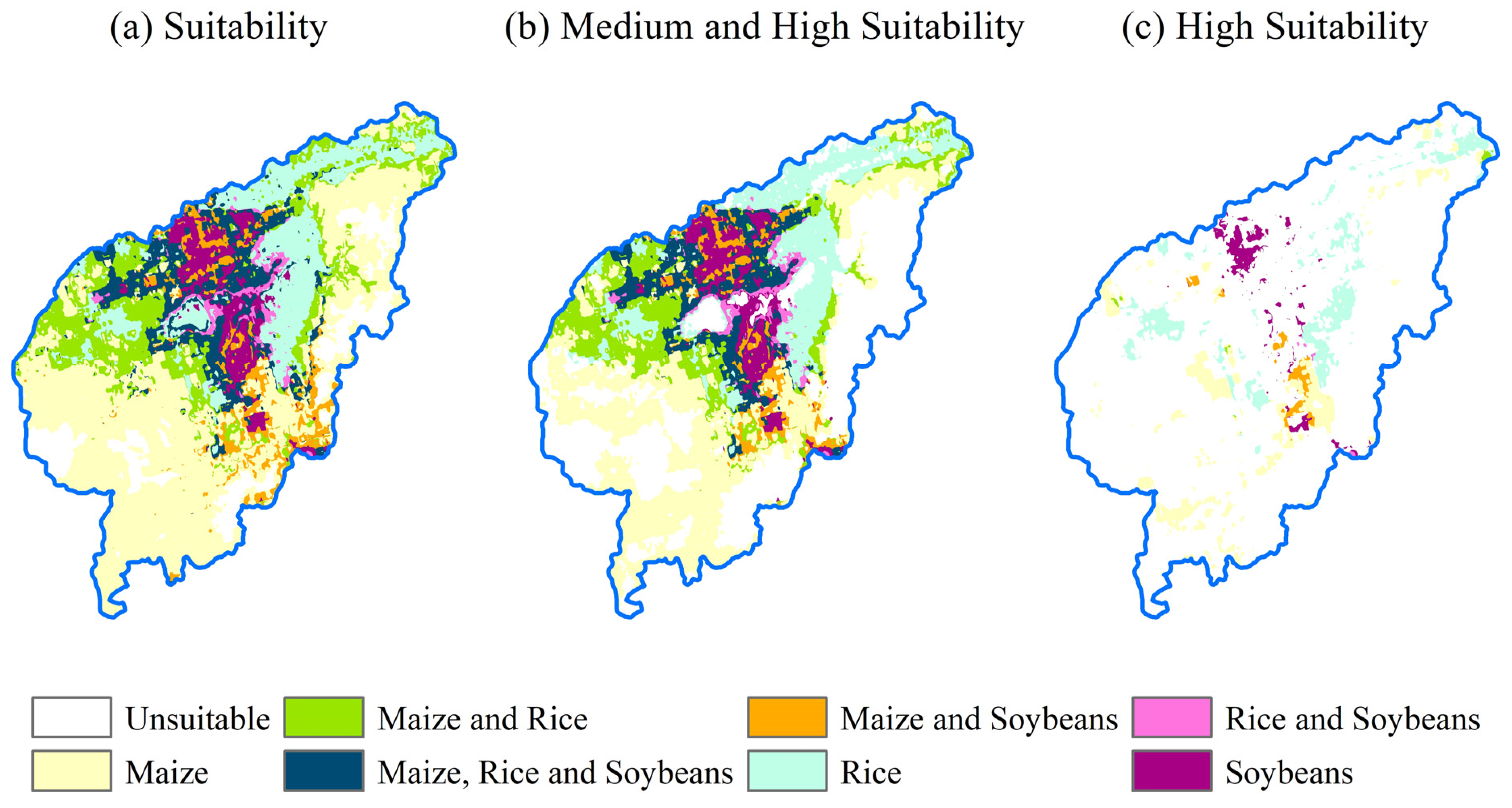

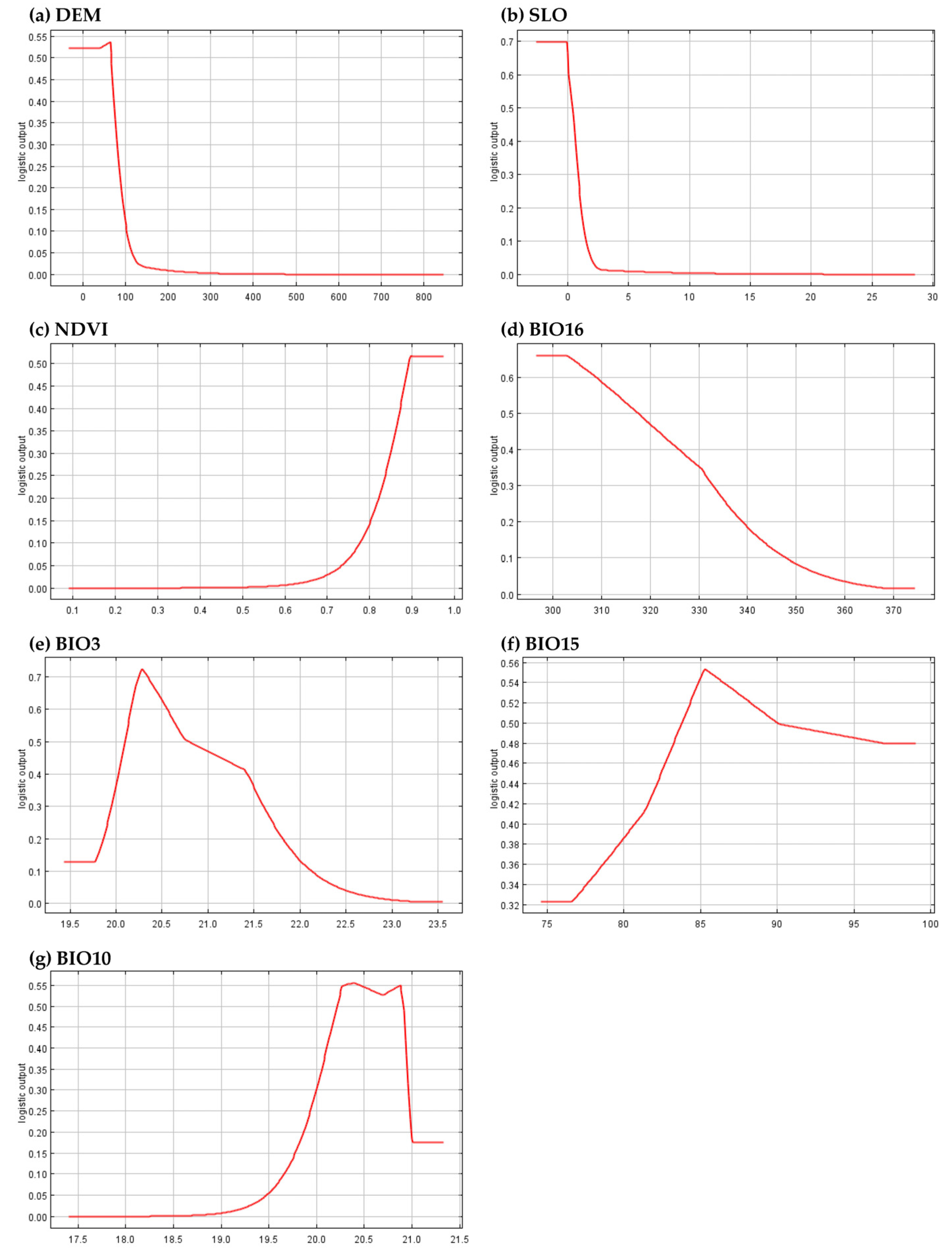
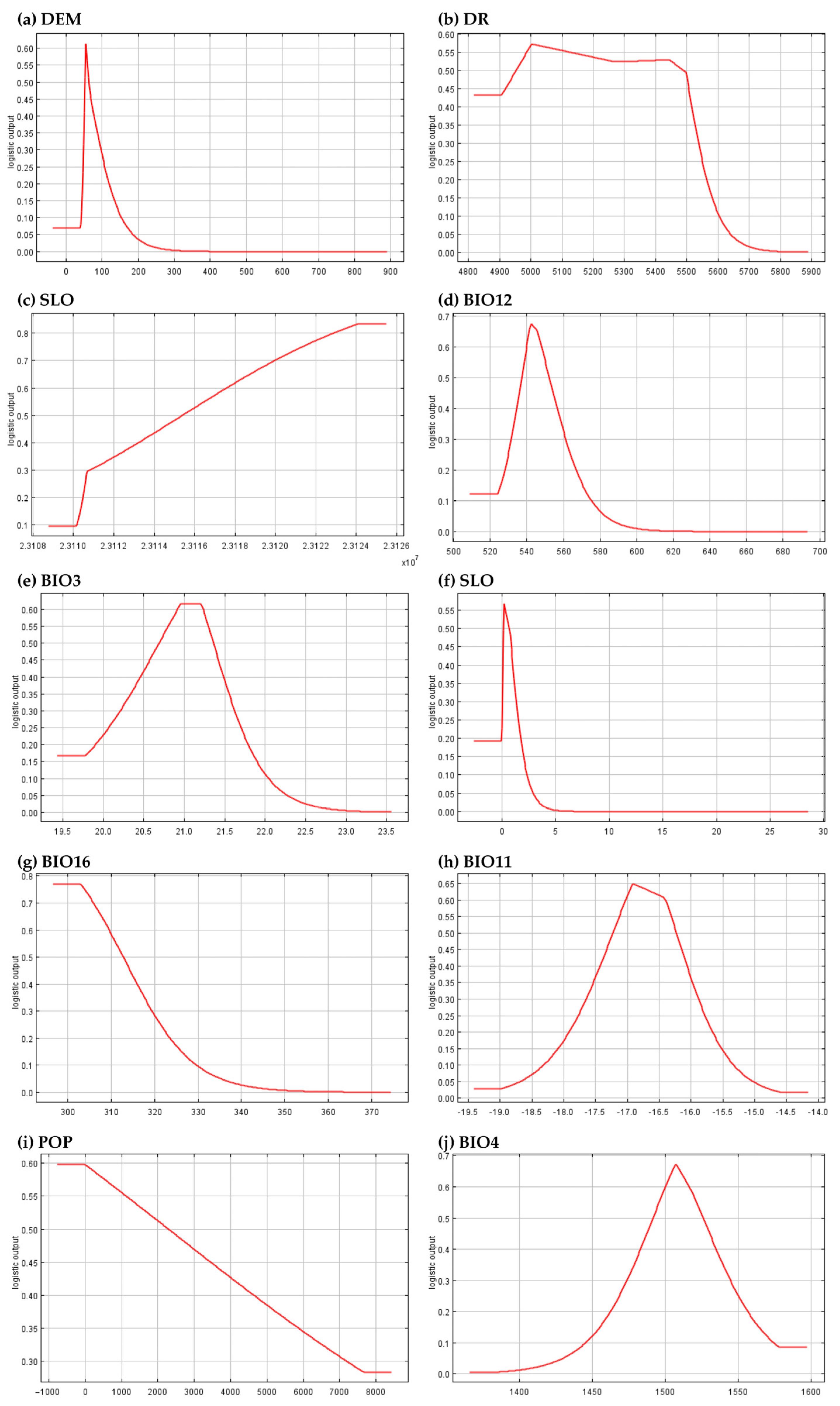

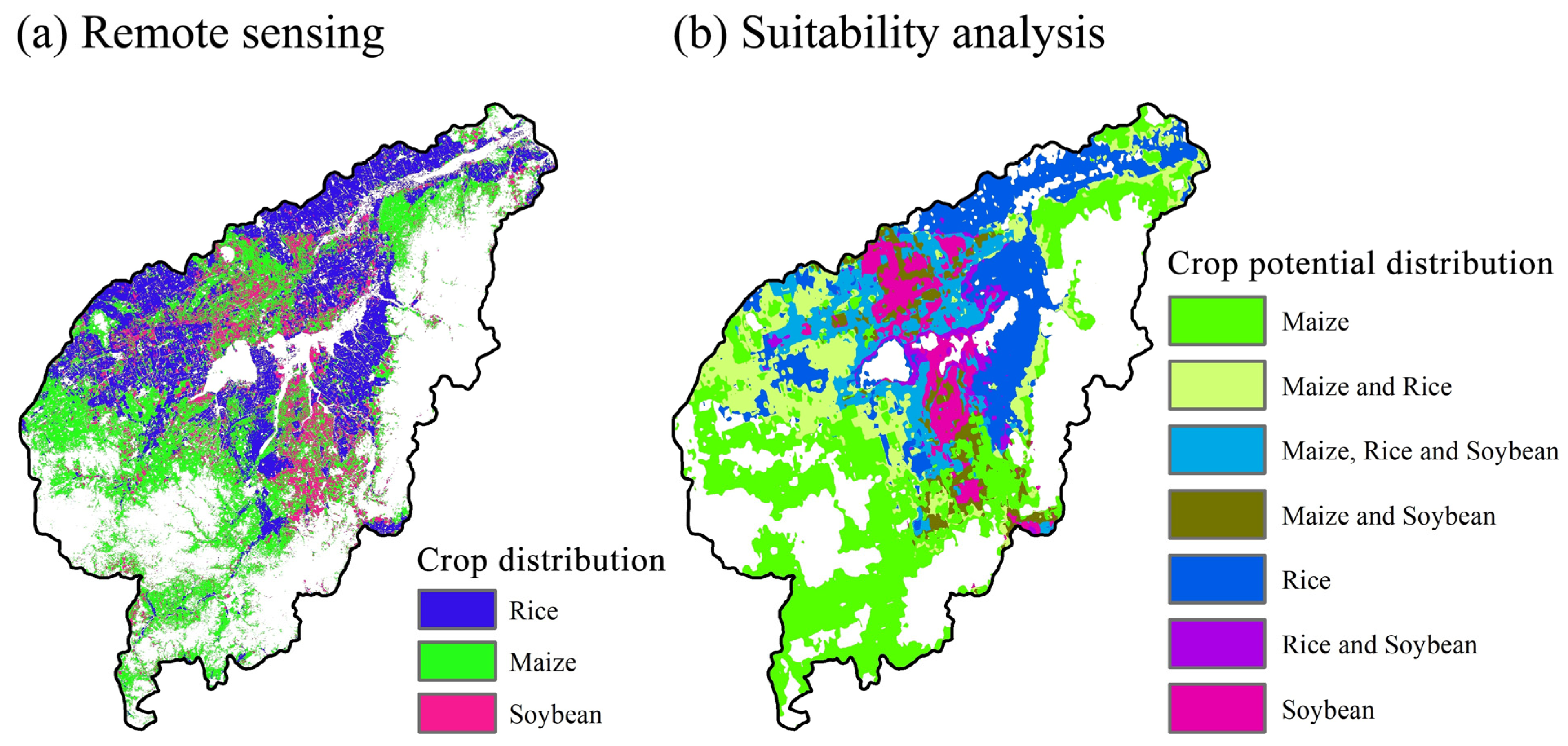
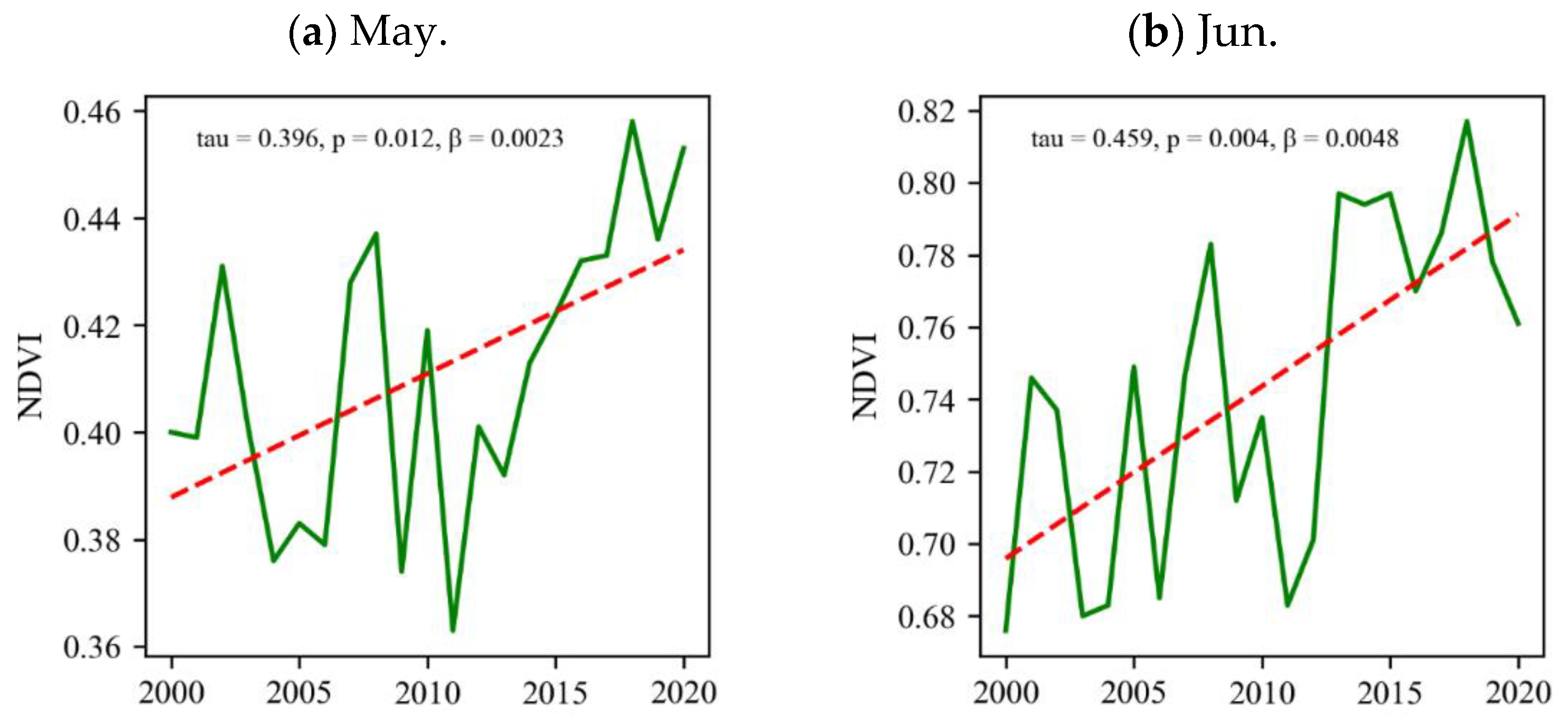


| Type | Factors | Abbreviation | Data Sources | |
|---|---|---|---|---|
| Climate Factors | Bioclimatic variables | Annual mean temperature | BIO1 | NMSDC |
| Mean diurnal range | BIO2 | |||
| Isothermality (BIO2/BIO7) (×100) (%) | BIO3 | |||
| Temperature seasonality (standard deviation × 100) | BIO4 | |||
| Max temperature of warmest month | BIO5 | |||
| Min temperature of coldest month | BIO6 | |||
| Temperature annual range (BIO5–BIO6) | BIO7 | |||
| Mean temperature of wettest quarter | BIO8 | |||
| Mean temperature of driest quarter | BIO9 | |||
| Mean temperature of warmest quarter | BIO10 | |||
| Mean temperature of coldest quarter | BIO11 | |||
| Annual precipitation (mm) | BIO12 | |||
| Precipitation of wettest month | BIO13 | |||
| Precipitation of driest month | BIO14 | |||
| Precipitation seasonality | BIO15 | |||
| Precipitation of wettest quarter | BIO16 | |||
| Precipitation of driest quarter | BIO17 | |||
| Precipitation of warmest quarter | BIO18 | |||
| Precipitation of coldest quarter | BIO19 | |||
| Sunshine | Sunshine duration | SUN | ||
| Nature Factors | Terrain | Digital elevation model | DEM | RESDC |
| Slope | SLO | |||
| Aspect | ASP | |||
| Vegetation | Normalized difference vegetation index | NDVI | GEE | |
| Water consumption | Evapotranspiration | ET | GEE | |
| Soil | Organic content | OC | CARSDC | |
| Total nitrogen | TN | |||
| Total phosphorus | TP | |||
| Total potassium | TK | |||
| Topsoil calcium carbonate (CaCO3) | TC | |||
| Ph | Ph | |||
| Pore available water capacity | PAWC | |||
| Soil type | ST | RESDC | ||
| Soil erosion | ERO | |||
| Human Activities | Socioeconomic factors | Distance from a water source | DW | GIS interpolation |
| Distance from the settlement | DS | |||
| Distance from the road | DR | |||
| Population density | Pop | RESDC | ||
| Gross domestic product | GDP | |||
| Future Climate | Bioclimatic variables with strong importance under the climate scenarios of SSP1-2.6, SSP2-4.5, SSP4-6.0, and SSP5-8.5 in BCC-CSM2-MR | BIO1–BIO19 | WorldClim |
| Maize | Rice | Soybeans | ||
|---|---|---|---|---|
| Area (km2) | Unsuitable | 2807.14 | 10,731.47 | 11,445.82 |
| Low suitability | 8821.37 | 5010.36 | 7967.24 | |
| Medium suitability | 12,978.77 | 8813.32 | 4438.23 | |
| High suitability | 1872.98 | 1430.01 | 1405.9 | |
| Suitable | 23,673.11 | 15,253.69 | 13,811.37 | |
| Percentage of Area | Unsuitable | 10.60% | 42.40% | 47.84% |
| Low suitability | 33.31% | 18.92% | 30.09% | |
| Medium suitability | 49.01% | 33.28% | 16.76% | |
| High suitability | 7.07% | 5.40% | 5.31% | |
| Suitable | 89.40% | 57.60% | 52.16% |
| Crop Distribution | Suitability | Medium and High Suitability | High Suitability | |||
|---|---|---|---|---|---|---|
| Area (km2) | Percentage | Area (km2) | Percentage | Area (km2) | Percentage | |
| Unsuitable | 2389.58 | 9.02% | 8203.82 | 30.98% | 22,811.33 | 86.14% |
| Soybeans | 1372.63 | 5.18% | 1341.13 | 5.06% | 404.36 | 1.53% |
| Rice | 3706.23 | 13.99% | 3449.38 | 13.02% | 1378.19 | 5.20% |
| Rice and Soybeans | 461.17 | 1.74% | 461.21 | 1.74% | 17.41 | 0.07% |
| Maize | 10,964.21 | 41.40% | 7104.26 | 26.83% | 1642.74 | 6.20% |
| Maize and Rice | 3578.34 | 13.51% | 2825.78 | 10.67% | 35.83 | 0.14% |
| Maize and Soybeans | 1420.76 | 5.36% | 958.44 | 3.62% | 194.18 | 0.73% |
| Maize, Rice, and Soybeans | 2590.24 | 9.78% | 2138.95 | 8.08% | ||
| Driving Force for Maize | Contribution | Driving Force for Rice | Contribution | Driving Force for Soybeans | Contribution | |||
|---|---|---|---|---|---|---|---|---|
| Percent | Cumulative | Percent | Cumulative | Percent | Cumulative | |||
| BIO5 | 17.6 | 17.6 | DEM | 36.4 | 36.4 | DEM | 18.4 | 18.4 |
| BIO3 | 17 | 34.6 | SLO | 23.2 | 59.6 | DR | 15.8 | 34.2 |
| BIO10 | 16.6 | 51.2 | NDVI | 9.3 | 68.9 | ST | 14.9 | 49.1 |
| DW | 5.8 | 57 | BIO16 | 3.7 | 72.6 | BIO12 | 5.1 | 54.2 |
| BIO1 | 5.2 | 62.2 | BIO3 | 3.6 | 76.2 | BIO3 | 5.1 | 59.3 |
| DEM | 4.8 | 67 | BIO15 | 2.6 | 78.8 | SLO | 4.9 | 64.2 |
| BIO12 | 4.4 | 71.4 | BIO10 | 2.5 | 81.3 | BIO16 | 4.8 | 69 |
| ST | 4 | 75.4 | BIO11 | 4.4 | 73.4 | |||
| BIO13 | 3.7 | 79.1 | POP | 3.5 | 76.9 | |||
| SLO | 3.5 | 82.6 | BIO4 | 3.4 | 80.3 | |||
| Maize | |||||
| SSP1-2.6 | SSP2-4.5 | SSP3-7.0 | SSP5-8.5 | Currently | |
| Unsuitable | 10.68% | 11.46% | 11.65% | 11.01% | 10.60% |
| Low Suitability | 37.00% | 41.11% | 41.20% | 40.29% | 33.31% |
| Medium Suitability | 47.75% | 47.39% | 47.40% | 46.17% | 49.01% |
| High Suitability | 4.57% | 2.04% | 1.74% | 2.53% | 7.07% |
| Suitability | 89.32% | 88.54% | 88.35% | 88.99% | 89.40% |
| Medium and High Suitability | 51.33% | 49.43% | 49.15% | 48.70% | 56.09% |
| Rice | |||||
| SSP1-2.6 | SSP2-4.5 | SSP3-7.0 | SSP5-8.5 | Currently | |
| Unsuitable | 42.80% | 43.77% | 45.14% | 45.62% | 42.40% |
| Low Suitability | 18.24% | 19.53% | 22.15% | 24.88% | 18.92% |
| Medium Suitability | 33.16% | 32.71% | 28.56% | 25.58% | 33.28% |
| High Suitability | 5.80% | 4.99% | 4.14% | 3.93% | 5.40% |
| Suitability | 57.20% | 56.23% | 54.86% | 54.38% | 57.60% |
| Medium and High Suitability | 38.96% | 36.70% | 32.71% | 29.50% | 38.68% |
| Soybeans | |||||
| SSP1-2.6 | SSP2-4.5 | SSP3-7.0 | SSP5-8.5 | Currently | |
| Unsuitable | 47.98% | 54.01% | 52.45% | 53.76% | 47.84% |
| Low Suitability | 29.21% | 28.22% | 29.12% | 29.11% | 30.09% |
| Medium Suitability | 17.75% | 13.86% | 14.01% | 13.18% | 16.76% |
| High Suitability | 5.06% | 3.91% | 4.41% | 3.94% | 5.31% |
| Suitability | 52.02% | 45.99% | 47.55% | 46.24% | 52.16% |
| Medium and High Suitability | 22.81% | 17.77% | 18.43% | 17.13% | 22.07% |
Disclaimer/Publisher’s Note: The statements, opinions and data contained in all publications are solely those of the individual author(s) and contributor(s) and not of MDPI and/or the editor(s). MDPI and/or the editor(s) disclaim responsibility for any injury to people or property resulting from any ideas, methods, instructions or products referred to in the content. |
© 2023 by the authors. Licensee MDPI, Basel, Switzerland. This article is an open access article distributed under the terms and conditions of the Creative Commons Attribution (CC BY) license (https://creativecommons.org/licenses/by/4.0/).
Share and Cite
Yin, J.; Wei, D. Study on the Crop Suitability and Planting Structure Optimization in Typical Grain Production Areas under the Influence of Human Activities and Climate Change: A Case Study of the Naoli River Basin in Northeast China. Sustainability 2023, 15, 16090. https://doi.org/10.3390/su152216090
Yin J, Wei D. Study on the Crop Suitability and Planting Structure Optimization in Typical Grain Production Areas under the Influence of Human Activities and Climate Change: A Case Study of the Naoli River Basin in Northeast China. Sustainability. 2023; 15(22):16090. https://doi.org/10.3390/su152216090
Chicago/Turabian StyleYin, Jian, and Danqi Wei. 2023. "Study on the Crop Suitability and Planting Structure Optimization in Typical Grain Production Areas under the Influence of Human Activities and Climate Change: A Case Study of the Naoli River Basin in Northeast China" Sustainability 15, no. 22: 16090. https://doi.org/10.3390/su152216090






